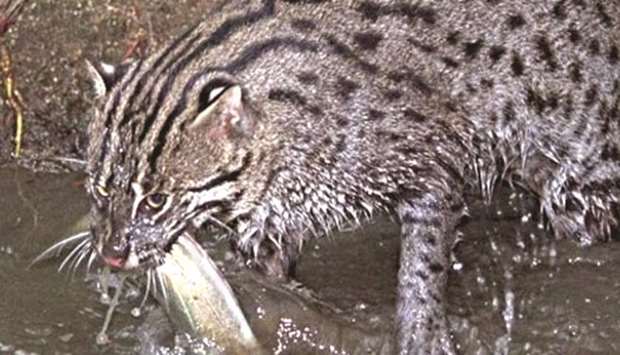Fishing cats, known as wetland ambassadors, have declined in Bangladesh rapidly due to loss of habitat and indiscriminate killing, two studies by conservationists have revealed.
Conservationists told newsmen in Dhaka that widespread habitat loss has confined the surviving fishing cats to water bodies around human settlements increasing human-fishing cat conflict.
In 2000, the International Union for Conservation and Nature (IUCN) declared fishing cats as an endangered species in South Asia, particularly in Bangladesh.
A recent study report posted on the Fishing Cat Working Group’s website reveals that in Bangladesh 28 incidents of killing of fishing cats were recorded between January 2010 and May 2017. Fishing Cat Working Group is an international conservation network.
During the period, 27 fishing cats were rescued and released later by the department of forest, said the study. Another study by IUCN and Cat Specialist Group of Species Survival Commission found in 2015 that direct killing, snaring, capture and subsequent starvation of cats, by the locals, are the main reasons for fishing cat mortality in Bangladesh.
The studies mapped at least 28 districts across Bangladesh where fishing cats were killed during the period.
Most of the incidents occurred in districts on the Padma River as well as the Chalan Beel, show both the studies.
But local populations also helped the department of forest in rescuing fishing cats from the wetland belt, show the study done by Fishing Cat Working Group in 2017.
Conservation biologist Sayam U Chowdhury, who was involved in both the studies, said direct killing of fishing cat takes place primarily because locals assume that fishing cats prey on their livestock, fish and poultry.
As fishing cats often are misidentified to be tiger cubs or other carnivores, locals beat and kill them out of fear and the dead animals are later hung for display, the studies found.
Fishing cat basically is a fish eater but would kill any small animal like poultry, ducks and geese, kids of goat and sheep that it can grab.
The nocturnal, solitary and shy animal is usually active at dawn and dusk. The animal is commonly sighted in wetlands and marshes as well as thickets on the banks of wetlands, said conservationists.
Professor Mohamed Mostafa Feeroz who led the status evaluation team of IUCN Red List 2016 says that fishing cats are facing habitat loss due to rapid filling up of wetlands and expansion of fisheries.
‘Fishing cats are often trapped by security nets placed by fisheries and are subsequently beaten to death,’ he said.
As occurrence of fishing cats around wetlands indicates good health of the water-body, they are fondly called the ambassador of wetlands.
Hence, local people should refrain from killing fishing cats, he said.
Conservationists strongly recommended proactive conservation initiatives including census of this endangered feline together with raising of public awareness.
Closure of wildlife rescue and rehabilitation centres across the country in December 2016 made rescue of trapped or endangered fishing cats and other animals impossible, said Wildlife and Nature Conservation Circle’s forest conservator Jahidul Kabir.
Continuation of the rescue centres could reduce mortality of the fishing cats and other endangered wildlife, he said.

Fishing cat
